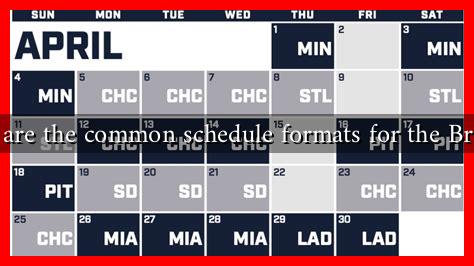-
Table of Contents
What are the Common Schedule Formats for the Brewers?
The Milwaukee Brewers, a Major League Baseball (MLB) team, have a rich history and a dedicated fan base. Understanding their schedule formats is essential for fans, analysts, and anyone interested in the dynamics of baseball.
. This article delves into the common schedule formats used by the Brewers, highlighting key aspects that define their season and how these formats impact fans and players alike.
Understanding the MLB Schedule Structure
The MLB season is structured to accommodate 30 teams, including the Brewers, and spans from late March to early October. The schedule is divided into several key components:
- Regular Season: The Brewers play 162 games during the regular season, typically from April to September.
- Spring Training: Before the regular season, teams participate in Spring Training, which usually occurs in February and March.
- Postseason: If the Brewers qualify, they enter the postseason, which includes the Wild Card Game, Division Series, Championship Series, and the World Series.
Common Schedule Formats
The Brewers’ schedule can be categorized into several formats, each serving different purposes and audiences. Here are the most common formats:
1. Home and Away Games
The Brewers alternate between home games at American Family Field and away games against other teams. This format is crucial for fan engagement and revenue generation.
- Home Games: Typically, the Brewers host 81 games at their home stadium, allowing fans to experience the excitement of live baseball.
- Away Games: The remaining 81 games are played at various stadiums across the country, providing fans with opportunities to follow the team on the road.
2. Series Format
Games are often organized into series, usually consisting of three or four games against the same opponent. This format allows for strategic planning and builds rivalries.
- Three-Game Series: Commonly used for divisional matchups, these series can significantly impact standings.
- Four-Game Series: Occasionally scheduled, these series provide teams with more opportunities to gain ground in the standings.
3. Interleague Play
Interleague play allows the Brewers to compete against teams from the opposite league (American League). This format adds variety to the schedule and attracts different fan bases.
- Rivalry Games: Matchups against teams like the Chicago White Sox or Minnesota Twins often draw significant attention.
- Special Events: Interleague games may coincide with special promotions or events, enhancing the fan experience.
Impact of Schedule Formats on Fans and Players
The schedule formats have profound implications for both fans and players. Here are some key impacts:
- Fan Engagement: Home games create a vibrant atmosphere, while away games allow fans to travel and support the team.
- Player Performance: The travel schedule can affect player fatigue and performance, particularly during long road trips.
- Broadcasting Opportunities: Different formats provide varied broadcasting opportunities, increasing the team’s visibility and revenue.
Conclusion
Understanding the common schedule formats for the Milwaukee Brewers is essential for fans and analysts alike. The structure of the MLB season, including home and away games, series formats, and interleague play, shapes the experience for everyone involved. As the Brewers continue to compete at a high level, their schedule will remain a critical aspect of their strategy and fan engagement. For more information on the Brewers’ schedule and updates, visit the official MLB website at MLB Brewers Schedule.





